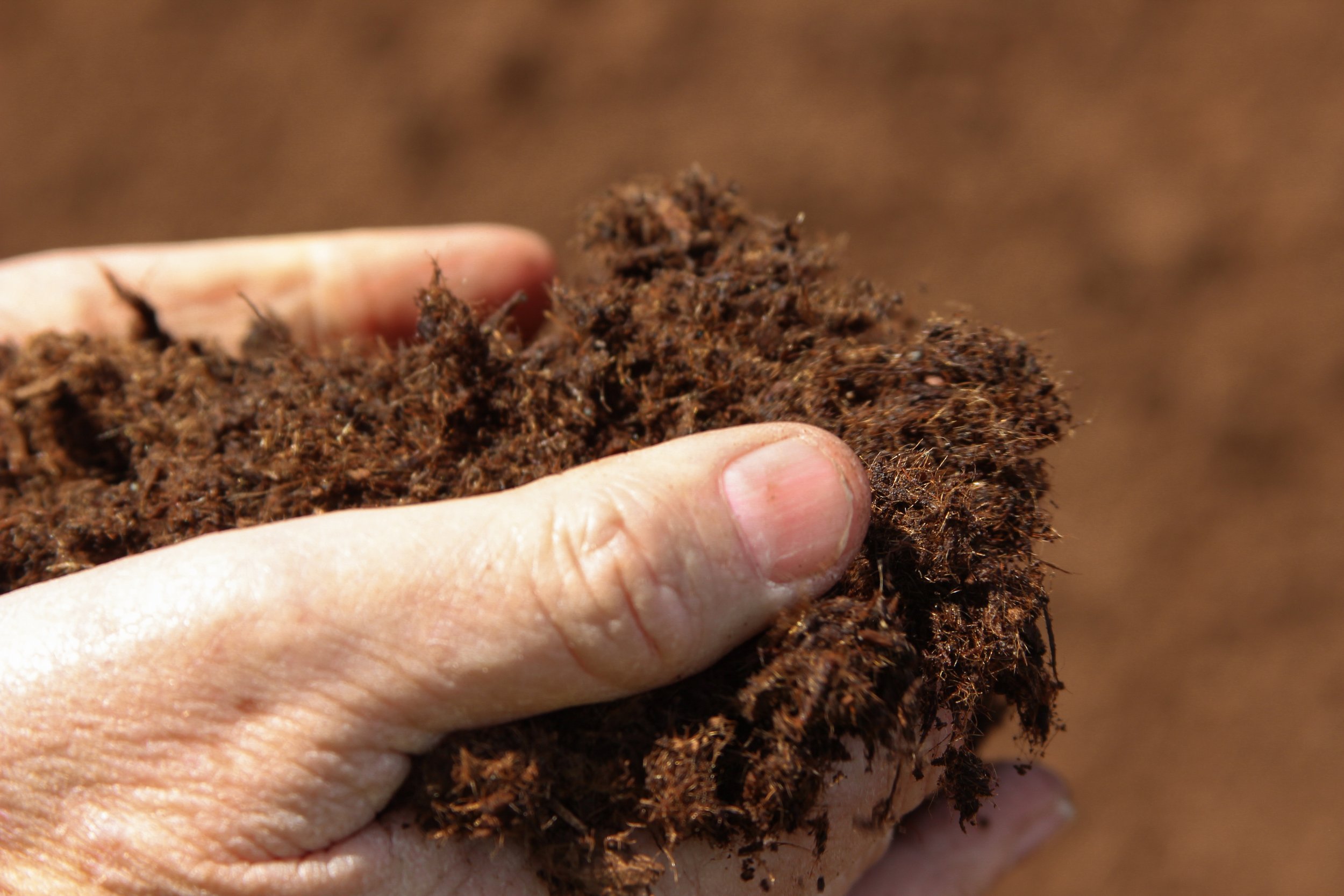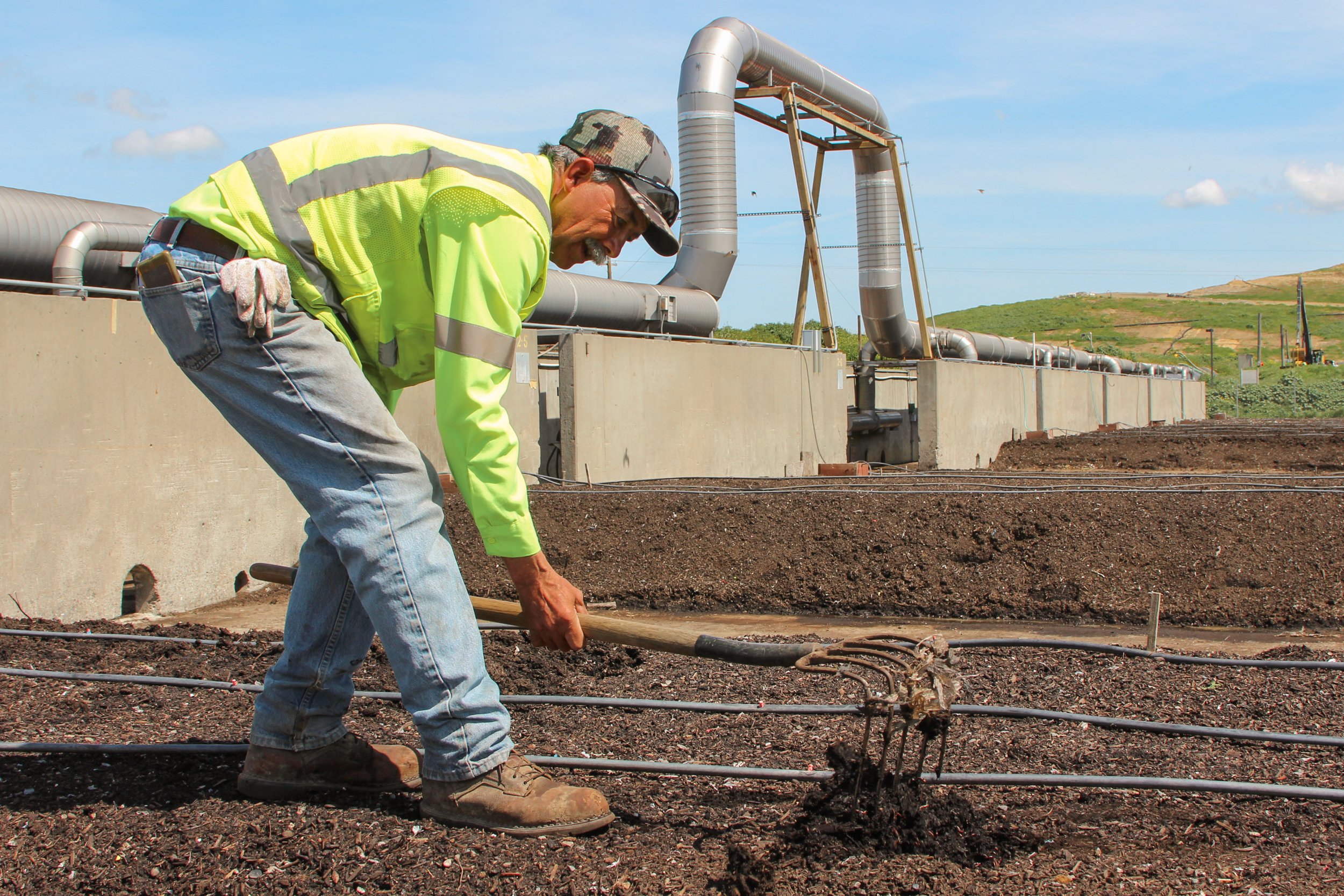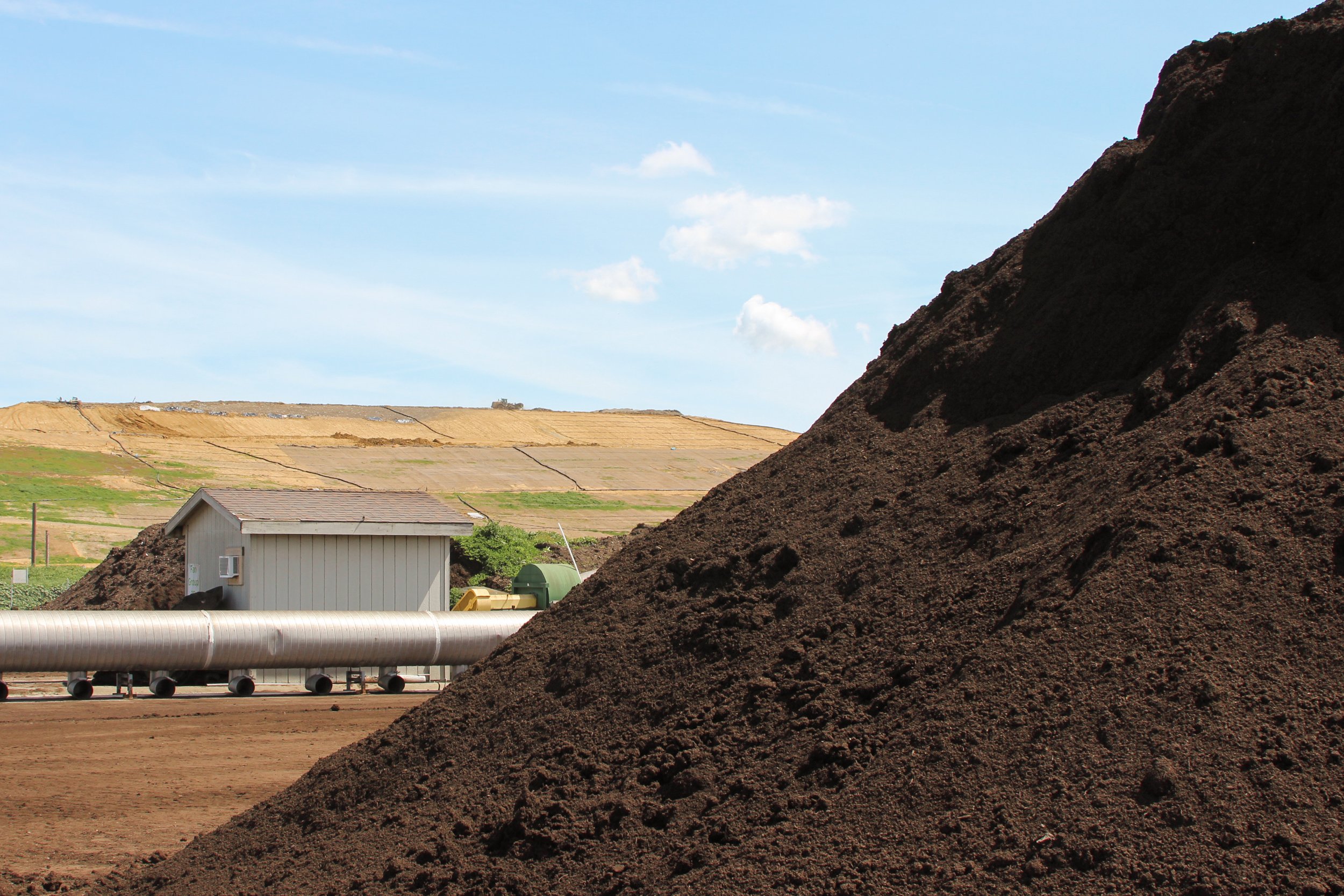
GROWING IN GARBAGE
Bay Area farmers turning green waste to gold while helping the planet.
BY OLIVIA WYNKOOP, FOR BAY CITY NEWSTo the garbage collecting company Recology, not all trash is the same. There’s one type of waste that constantly trails behind us every breakfast, lunch and dinner, and is increasingly showing up in out landfills: food scraps.
The eggshells, the coffee grounds, the banana peels, the brown leaves off the outside of lettuce — though this could be considered “garbage,” it can actually turn into a material that a plethora of Northern California farmers find precious: compost.
“It’s the most important type of garbage that exists,” Recology representative Robert Reed said.
The material serves as a natural sponge to retain water in soils, which helps hold moisture in the roots and keeps the microorganisms in soil thriving. Healthier soils also make our sprawling agricultural lands more resilient to flood and drought conditions, erosion and even wildfires.
“We’re turning farms into water reservoirs. And you know what? There’s no dam,” Reed said.
Every day, over 4 million pounds of feedstock like food scraps, yard clippings and soiled paper arrive at one of the five compost facilities in the state run by Recology, which serves San Francisco and more than 100 other communities in California, Oregon, Washington and Nevada.
Recology says it diverts 550 tons of San Francisco’s food waste from landfills every day to turn it into materials for local farms. It’s helping to balance out the large energy output it takes for our food to come to us.
“Composting is like recycling on steroids. Had we realized this 50 years ago, we’d have gone after the food scraps much earlier,” Reed said.
Not everyone can implement San Francisco’s program flawlessly. Cities are beginning to roll out programs, but slowly. CalRecycle has allocated $60 million in local assistance grants, but the League of California Cities, an advocacy organization for cities in the state, said they need hundreds of millions for the development, implementation, outreach and capacity of these programs.
“This funding request alone is not sufficient to achieve the state’s organic waste recycling targets, especially in light of the estimated $20 to $40 billion anticipated total implementation cost; however, it will go a long way to help local governments and accelerate the development of the programs necessary to achieve those goals and to carry out early implementation activities,” reads a 2021 letter from the city league and a list of other organizations.
Recology representative Robert Reed. (Olivia Wynkoop/Bay City News)
“Composting is like recycling on steroids. Had we realized this 50 years ago, we’d have gone after the food scraps much earlier,” Reed said.
And it all starts with the kitchen pail. San Francisco residents might be accustomed to dumping their plate scrapings into their green bins, but the city’s curbside compost program is actually a leading beacon in the worldwide effort to reduce waste.
In 2009, San Francisco was the first city in the country to mandate compost and recycling for its residents and businesses, following a voluntary pilot program launched in the 1990s.
The city said its initiatives directly influenced the passage in 2016 of Senate Bill 1383, which called on California cities to implement food scrap collection services by 2022 and significantly cut the amount of organic materials being sent to landfills.
Organic waste in landfills is growing, and in California, is responsible for an estimated 20 percent of the state’s methane gas emissions — a pollutant 84 times more potent than carbon dioxide — and contributes a significant amount of harmful air pollutants, according to the California Department of Resources Recycling and Recovery (CalRecycle).
The department is aiming to divert three quarters of its organic materials out of landfills by 2025, though estimated implementation will cost $20 billion to $40 billion over the next 10 years.
While organic recycling infrastructure has already begun to grow, more needs to be done to completely achieve the state’s ambitious targets, according to CalRecycle’s latest analysis of SB 1383 in 2020.
Greg Pryor, Recology’s director of organics, sifts through a compost blend. (Olivia Wynkoop/Bay City News)
Preserving the land for the next generation
Take a drive to Napa during the spring, and streaks of white and yellow will blur among sprawling rows of crop and vine. There’s tiny blooming flowers between the fruit — these are called cover crops, and they are compost’s partner in crime.
“This is the best example of local recycling I can give you. The food scraps from San Francisco go onto a farm here in Northern California … this is here,” Reed said, as he eagerly snapped photographs of the abundant green growth sprouting throughout the valley after the recent winter rains. Recology sells compost to hundreds of farms in the area.
Mustard is a common cover crop found in California, known for its yellow flowers and deep root system that can hold a lot of water in the soil.
Nestled on the valley floor of Napa Valley sits the Groth vineyard, a family winery in Oakville hailed as the first in the U.S. to produce a 100-point wine in 1985. Present-day vineyard manager Ben Forgeron said he is constantly looking ahead to preserve the winery’s legacy for generations to come, and that means investing in regenerative farming techniques.
Ben Forgeron, vineyard manager of Groth. (Olivia Wynkoop/Bay City News)
In 2018, the vineyard kickstarted a sustainable replanting effort to ensure the land remains abundant. In recent years Groth phased out synthetic fertilizers and frequent tilling to embrace compost and strategic blends of cover crop that keep their soils healthy and cut out insects. Five years ago, the vineyard stopped using the herbicide Roundup, which required a lot of upfront investments like new tools for tractors, employee training and a bit of lost fruit. Though it took more effort than spraying down herbicide, Forgeron said the payoff was worth it.
“If you’re only worried about the vines themselves and you’re not focused on what’s growing in between the vines, your head’s probably not in the right direction,” Forgeron said while looking out toward the vineyards he watches over.
“If you’re only worried about the vines themselves and you’re not focused on what’s growing in between the vines, your head’s probably not in the right direction,” Forgeron said.
Groth’s 165-acre estate in Oakville is located on the east side of Conn Creek, in a region notorious for its lush Cabernet Sauvignon wines. The winery’s Reserve Cabernet Sauvignon — its crown jewel — is grown in a 27-acre plot of land along the old riverbed, with gravelly, sandy soils.
After harvest, Forgeron typically adds 10 tons of Recology compost per acre to retain the land’s topsoils. Some vineyards only apply compost directly around the area where the vines are growing, but he likes to apply it across the entire width of the vineyard row.
The vineyard has also sowed their own blends of cover crops between the vines, based on the soil’s needs. Legume-based cover crops are used to lower the populations of nematodes, a microscopic roundworm species that can destroy roots, while plants like daikon radish and mustard plants mitigate nitrification, and grass blends sop up excess water in the heavier soils that get muddy during the rainy season.
“We want the cover crops to balance out conditions, so to speak,” he said.
A flock of sheep graze in between the vines at the Groth Vineyards & Winery in Oakville. (Olivia Wynkoop/Bay City News)
Also invited on the property is a neighborhood sheep flock, which chews down vegetation to cut back the use of tractors and prevent the growth from turning into dry wildfire fuel. They are becoming quite popular nowadays, said Forgeron.
“It’s getting hard to find sheep people, there’s a really big competition out there,” he said.
It is hard to quantify the variables that influence a wine’s taste, he said, but he is certain that high quality wine cannot be produced without good soil. The less chemicals he has to use, the healthier the soil will be, he said.
“That’s my goal as the vineyard manager, to do everything I can to make that best possible fruit,” he said.
New beginnings
The work is just getting started for first-generation farmer couple Mike and Courtney Wilkinson of Wilkinson Acres, a certified organic fruits and vegetables farm in Fairfield.
Roughly 20 miles away from the Vacaville Recology site, the couple is joined by two volunteers to pile on truckloads worth of Recology compost and build up their soil organics at a location they moved to in February.
The Wilkinsons first bought a plot of land five years ago to sell organic, small-batch produce to the neighboring community, taught by the internet and friends. They grow a variety of crops on 180 beds of compost. Each bed has a pattern of different produce growing simultaneously to build a canopy, which keeps weeds at bay and minimizes the need for tilling.
Mike Wilkinson said he uses significantly more compost than most farms do, because it is quite literally the foundation of their work. The difference in their crop after starting to use compost was like night and day, he said.
“I finally felt in my fourth year that it wasn’t just luck anymore. We were onto something,” Mike said.
In early April, they completed planting beds that contained chard, lettuce, radishes and green bunching onions, all placed around each other and with different harvest times. Next on the agenda is planting tomatoes, potatoes and peppers. The large pile of compost at the front of their property would be used in the matter of two days, they said.
“Whenever our customers ask us, I tell them I have two secret ingredients — it’s called compost and fish emulsion. They’re both stinky, but all I smell is money,” Mike said.
They envision the space as a place for people to not only learn how their food is made, but care about where it comes from.
“I want to make farming cool,” Mike said. “I want to be a farmer that connects with younger potential farmers, I want to be able to implement new technology without relinquishing our morals and values.”
Rows of freshly planted crops at Wilkinson Acres in Fairfield. (Olivia Wynkoop/Bay City News)
Recently planted crop beds with a compost pile at Wilkinson Acres in Fairfield. (Olivia Wynkoop/Bay City News)
The nitty-gritty
The compost used at Groth Vineyards and Wilkinson Acres was processed at Recology’s Jepson Prairie Organics facility in rural Solano County. The facility receives between 350 and 400 tons of materials from Solano and Sacramento counties every day.
The site is considered “ground-zero” for Recology’s composting operations. San Francisco’s organic materials used to be processed here before Recology developed their site in Vernalis in San Joaquin County, which now accepts organic waste from 20 cities in the Bay Area.
It provides a variety of compost blends, including custom blends, to many farms in Northern California.
Here, workers shred and arrange food and yard scraps into large piles. The main focus in making compost is to create conditions for microorganisms to break down compost into smaller pieces. That can only happen if the microorganisms have food, water and air.
A Recology worker tends to Recology’s vermicompost beds. (Olivia Wynkoop/Bay City News)
So, the company pulls air through the zones of a pile via a vacuum system. The recent heavy rains have kept compost soils moist, but in the summer the company will spray them down to make sure the microorganisms can get a drink. A hefty amount of yard waste is distributed amongst the piles for a higher bulk density, which allows more air to move through.
Thirty days later, the material is formed into low rows called windrows, where it cures and turns occasionally for another 30 days. Once it is screened, the compost is cured for another three weeks.
Some buy the material as is, and others opt to add additional soil amendments in set or custom blends. Recology can add materials like gypsum, lime, sandy loam, rice hulls and redwood sawdust to a compost blend, based on what nutrients and minerals farmers need to improve soil health.
“It’s very tough to get farmers away from their conventional practices, but once we got some to bite, more followed,” said Pryor.
On site there are also 17 raised beds of vermicompost, which is essentially red wiggler worm castings that contains compost.
“When you dig up your garden and have worms, you know you’ve got good soils,” said Greg Pryor, Recology’s director of organics who oversees the company’s eight compost facilities.
A scoop from the vermicompost bed brought forward an unruly number of wriggling worms. “You can go through this whole pile, and it looks just like this.”
Nutrients are taken away from the farm every harvest season. The ultimate goal for Recology is to help farmers bring their soils back in balance with nutrient-rich materials.
“It’s very tough to get farmers away from their conventional practices, but once we got some to bite, more followed,” he said.
Using a sustainable system
Bob Shaffer, an agronomist and owner of a coffee plantation in Hawaii, regularly consults vineyards and farms across the Pacific Coast on using the material that adds stable forms of carbon, microbes, energy and nutrients to their soils.
“Food waste is the real gold of the recyclable materials,” Shaffer said. “The cooperation of the public is so key, and it just taps into the bucket for us. We’ll compost it, and we’ll return that compost out to soils.”
So what makes compost so valuable? It feeds the essential bacteria and fungi hiding in it with a high-quality carbon source called humus, which is soil organic matter that comes from decaying plant and animal matter, said Schaffer.
“It is like a synergistic or leveraged management tool when you use compost,” he said. Shaffer said sustainable farming is not just about laying down compost, but also pairing it with cover crops, regularly testing soil and using tillage as an occasional, beneficial disturbance. Combining these methods yields more sequestered carbon, better crops and improved soil health, he said.
“We need a system of cultural practices, in which compost is a key part, to make reliable investments that we can project will be a positive for soil management on a farm.”
Cover crops grow between vines to keep the soil healthy. (Olivia Wynkoop/Bay City News)
And farmers are looking for help to make the switch. Just last September, Sonoma and Marin counties announced their plan to launch a partnership program that will form a regional supply chain of dairy and livestock products made with farming methods that reduce or sequester carbon. Organizers from the Sonoma Marin Ag and County Climate Coalition say they received an overwhelming response from farmers wanting to join the program.
Funds come from the U.S. Department of Agriculture’s Partnerships for Climate-Smart Commodities program, which is providing millions to local agricultural pilot projects around the country. The USDA predicts that the funds will engage over 25 million acres of land in climate-friendly techniques.
“This is the first time in our lives where we’re in this double-win position,” Shaffer said. “As farmers, we can put more carbon in our soil, have a healthier soil and take the carbon from where it’s escaped and put it back where it belongs.”










